The logic, at its simplest, goes like this: if we feel, deep down, like a piece of excrement whose very existence is unwanted, it then follows and seems entirely plausible that enemies should right now be plotting to destroy us, that the government might scrutinise us and put us in jail, that our partner might leave us and that we should be imminently disgraced and mocked by strangers.
Restoring Dignity to Our Animal Kin
Anthropologist Amanda Stronza reflects on death, grief, and the profound interconnections between animals and humans.
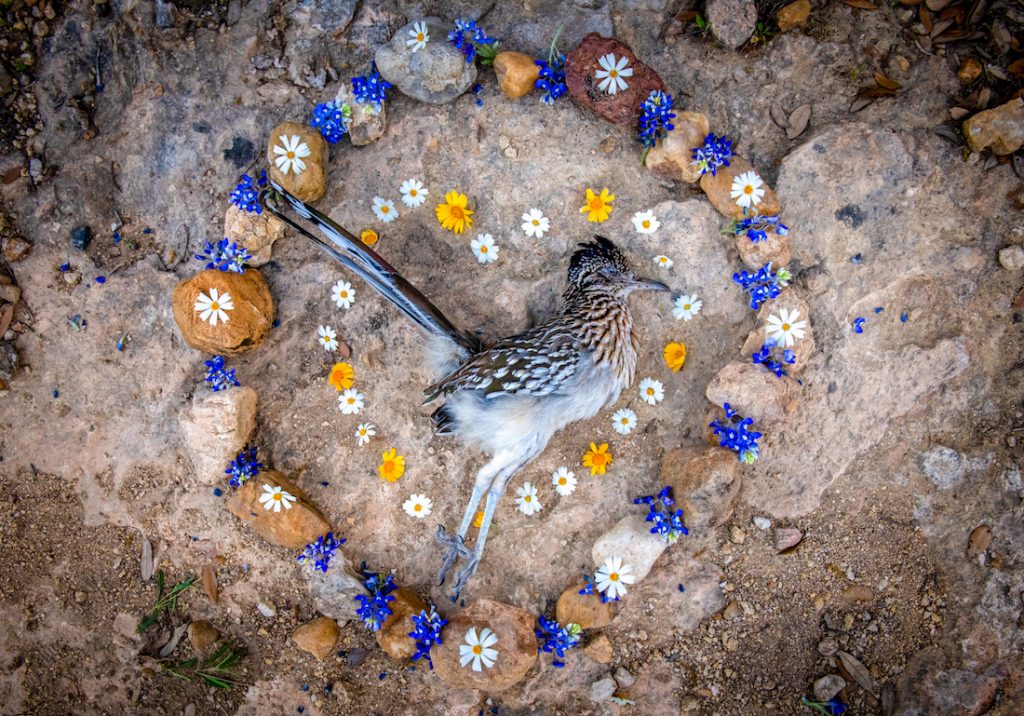
Is there a disconnect between what we love and how we live?
For the last thirty years, anthropologist Amanda Stronza has been investigating this question through her studies of the relationships between humans and animals. Her research and work in applied conservation have taken her around the world, from Botswana to the Amazon, where she has investigated what influences humans to care about and interact with certain species the way we do.
In recent years, Stronza has become known for her practice of rescuing the bodies of animals killed on roads, taking them to a soft and quiet place, and creating intricate memorials for them. Her photographs of these memorials, along with her writings about each animal she honors, are widely shared on social media platforms and displayed in photography exhibitions. In a conversation with Tricycle, Stronza reflects on what this practice has taught her about the dynamics between animals and humans, as well as how we understand death and experience grief. She also discusses the significance of creating these animal memorials alongside her beloved companion, a cattle dog named Matilda, who recently passed away.
Can you describe your practice of honoring the lives of animals killed on roads? I find animals in many places—on trails and sidewalks, as well as in my backyard—but most of the animals I find are on roads. If I’m driving and I see an animal that appears to be in a condition where I can move or lift them, and if I can stop my car without causing anyone else danger, I stop.
I move the animals for a few reasons. My aim is to restore some kind of dignity. It’s so hard for me to see animals left the way they are. I understand why they are killed, and I understand that we can’t all stop because it’s too dangerous. But I also believe that leaving them there like trash or treating them like the word many people use to describe them—roadkill—is so insulting. I want to show some respect and love to this animal, acknowledge that they’ve already died, and allow them to rest in peace.
I also want to show respect and love for the animals who come and feed on the dead animal. Many vultures get killed by cars, so I move the animal to help other animals who come and live from the dead.
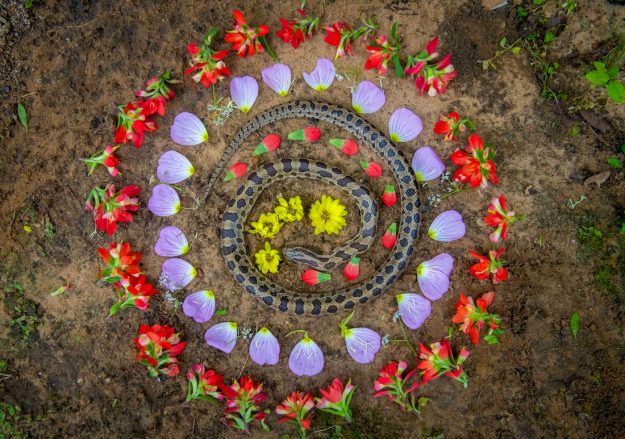
How do you go about creating the memorials for each animal? Creating the memorials feels very meditative and sacred to me. When I can, I bring the animals that I find to my home so I can spend more time creating something beautiful. I never bury the bodies. Instead, I place the body in a soft, quiet place where other animals—like coyotes, vultures, opossums, or foxes—can eventually come and take the animal. For the memorial, I look for whatever is around me that is available. In the winter, I usually gather and arrange dead leaves, branches, weeds, and rocks.
If I don’t have much time, or if I’m far from home, I create a memorial on the side of the road. I choose someplace that’s soft because I don’t want the animal on the asphalt. When I’m on the side of the road, I’m aware of the silence of the space where I’m creating the memorial. In the corner of my eye, I can see the whoosh of the traffic and sense the violence of where they died compared to the space where I am trying to memorialize and honor them. I believe they feel that respite and the sanctuary of that quieter space.
A big part of my process is also writing about each memorial. The stories I write and share feel like obituaries or testimonies to the life of the animal, so I consider these stories part of the memorial. The written word is meant to be an homage to that particular animal. When I write about a squirrel that died, I want to honor that individual squirrel. I want to honor where I found the squirrel and how the squirrel died. That animal is not just another dead squirrel; that squirrel had a life and a personality and a family. That squirrel had memories and stories. Creating the memorial honors the life of that animal the way we would honor the life of the human.
Part of your practice is photographing the memorials. You wrote in one Instagram post: “I photograph the animals not to sensationalize or objectify, but rather the opposite—to show what we fail to see, to look rather than look away, to honor what we tend to ignore.” Can you share more about that? Before taking the photos, I consciously try to make the memorial beautiful. I pointedly cover wounds. I don’t show blood. If the body is contorted, I photograph the animal in a way that they don’t look contorted. I’m not trying to hide death or the horror of how they died on the road. I just want people to feel comfortable to look. I am afraid that if the images were gruesome in any way, people wouldn’t look. So I try to make death beautiful.
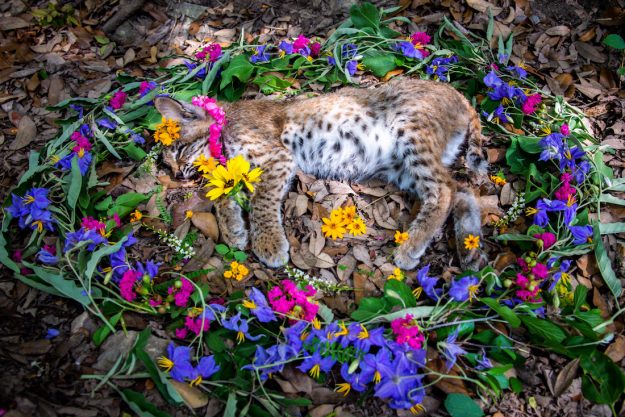
Through my photos, I’m also asking us to not be afraid to look at death. I feel like we can be so afraid of death in our society. We are conditioned to look away and to talk about dead animals as gross. It’s so objectifying. Many people can’t even bear to look at an animal killed on the road.
By creating the memorials and photographing and sharing the stories of the animals, I’m asking us to look more closely and to think about the life of that animal. I also want us to think about who we are as humans and what our role is.
Your dog Matilda was, and very much still is, a special person in your life. Can you talk about Matilda and how your relationship with her shaped the way you think, understand, question, and experience life? Matilda was with me for almost every memorial I created. There was something astounding about her approach to the memorials. She saw many dead animals in front of her: snakes, squirrels, doves, bobcats. I never kept her away from their bodies. She would smell them and step gingerly over them, or move around them in a respectful way. She would tap into me and the circumstances and sense that there was reverence around the animal.
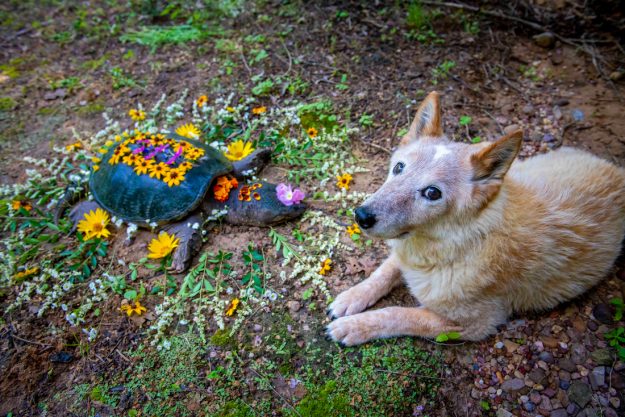
Since she died, I’ve been thinking about hierarchies of grief, or the different forms of grief we’re allowed to give different kinds of animals in our lives. When a human we love dies, we have all these rituals, norms, and tacit understandings of how we are allowed to grieve. When a companion animal dies, it’s understood that these animals are family, and of course we grieve for a dog or cat. But I can’t take bereavement leave from work even though Matilda was the most important person in my life. We acknowledge that companion animals are family too, but only so far.
There are also almost no norms for grieving wild animals. Is there a place to grieve the dead squirrel? Or is that mocked? Sometimes people even respond to what I’m doing with chagrin. There is so little room to grieve the animals who live among us and to think of them as family. That’s part of what I’m exploring and asking us to think about.
You’ve quoted Thich Nhat Hanh and his teachings on interbeing in some of your writings. How have your experiences shaped your understanding of interbeing and interconnection? I have been reading Thich Nhat Hanh’s book No Death, No Fear. It gives me so much peace to think about the concept of “no birth, no death.” To describe this, he writes about ocean waves and how we don’t grieve when an ocean wave transitions into the surf. The wave just becomes one with the rest of the ocean. I’ve been thinking that Matilda was this beautiful wave, and I’m a wave, and you’re a wave, and waves are very real. We’re all water, after all. I’m wondering if I can feel that way about Matilda too. If I can see her as transforming into one with me.
Nhat Hanh also talks about interbeing in the example of clouds transforming into rain. I understand that concept, and yet it’s the human condition to hold on to our attachments to the cloud. I’m so attached to Matilda, and it has been very hard to let go. I suppose that’s why it takes many lifetimes to figure out.
Another way I think about interconnection is witnessing how much love there is for Matilda in the world. After she died, I worried about posting and sharing the image of the memorial I made for her body. There’s that hierarchy of grief again—I wondered if people were going to be able to bear seeing Matilda memorialized in the same way that I memorialize a squirrel. The most common response I heard, however, was from people thanking me for sharing that very private and intimate moment. So, in this way, Matilda wasn’t mine. She wasn’t my dog. She was a person in the world so many people loved. I just happened to be her best friend who could help everyone grieve.
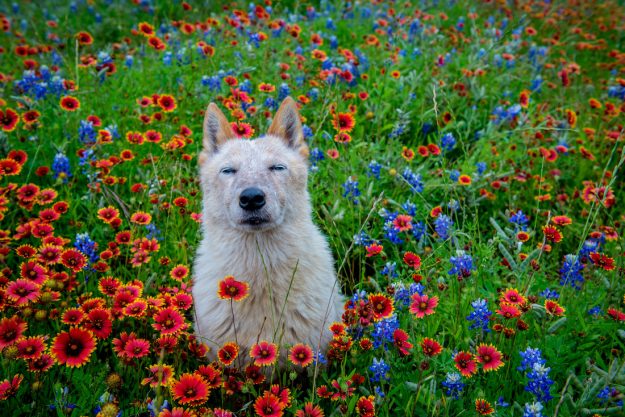
Every day, people all over the world send me photos of memorials that they made. People write to me about death and grief and human loved ones they lost and how seeing animal memorials has helped them grieve. It also helps them talk to their kids about death and honoring animals.
It’s so affirming to me how people want to talk about death and grief. Instead of death being perceived as gloomy and gruesome and scary, I believe we can talk more about the beauty of death and its connection with life. There can be a space for that.
⧫
You can view more of Stronza’s work on her website and her Instagram page.





No comments:
Post a Comment